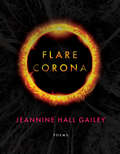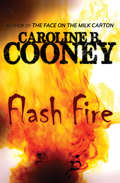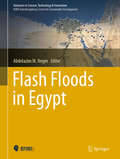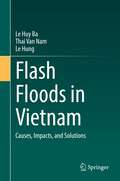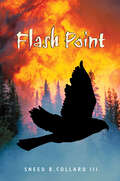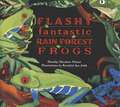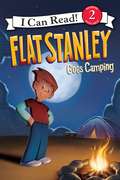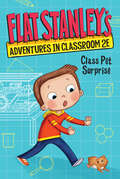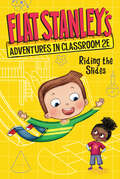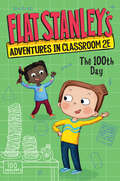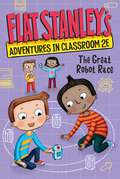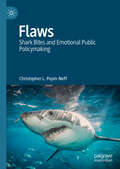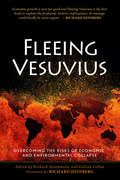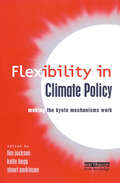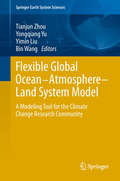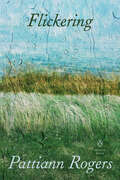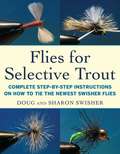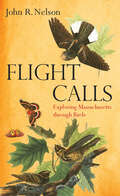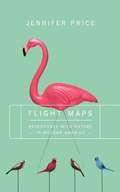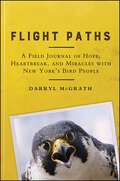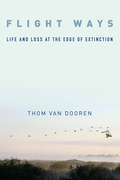- Table View
- List View
Flare, Corona (American Poets Continuum Series #201)
by Jeannine Hall GaileyAgainst a constellation of solar weather events and evolving pandemic, Jeannine Hall Gailey’s Flare, Corona paints a self-portrait of the layered ways that we prevail and persevere through illness and natural disaster.Gailey deftly juxtaposes odd solar and weather events with the medical disasters occurring inside her own brain and body— we follow her through a false-alarm terminal cancer diagnosis, a real diagnosis of MS, and finally the onset of the coronavirus pandemic. The solar flare and corona of an eclipse becomes the neural lesions in her own personal “flare,” which she probes with both honesty and humor. While the collection features harbingers of calamity, visitations of wolves, blood moons, apocalypses, and plagues, at the center of it all are the poet’s attempts to navigate a fraught medical system, dealing with a series of challenging medical revelations, some of which are mirages and others that are all too real. In Flare, Corona, Jeannine Hall Gailey is incandescent and tender-hearted, gracefully insistent on teaching us all of the ways that we can live, all of the ways in which we can refuse to do anything but to brilliantly and stubbornly survive.
Flash Fire (Point Ser.)
by Caroline B. CooneyWill the California wildfires bring Danna the summer excitement she craves?In the Southern California suburb of Pinch Canyon, among the swimming pools and tennis courts, fifteen-year-old Danna Press finds her summer life so dull she longs for some cinematic excitement. A kidnapping? An earthquake? A presidential assassination attempt? Even the scary wildfires she watches on TV, raging in nearby Los Angeles, seem like they would liven things up. Though the wildfires are miles away with little to no chance of coming near her home, Danna has a contingency evacuation plan in place—her kittens and the neighbor&’s horses first, her brother Hall, second. Her parents are safely at work. But in an instant the fire expands and threatens everything Danna and the other Pinch Canyon residents hold dear. In an action-packed hour and a half, minute by minute, the wildfires will alter the lives of everyone who lives and works in Pinch Canyon—including seventeen-year-old Elony, a recent immigrant, and her young charge, Geoffrey; handsome teenager Beau Severyn and his awkward little sister, Elisabeth; and the firefighters themselves. This ebook features an illustrated biography of Caroline B. Cooney including rare images and never-before-seen documents from the author&’s personal collection.
Flash Floods in Egypt (Advances in Science, Technology & Innovation)
by Abdelazim M. NegmThis book presents the latest findings and information on flash floods in Egypt and presents case studies from various regions throughout the country. The quantitative and qualitative dimensions of these flash floods are discussed on the basis of statistical analysis and field observations. The book covers a broad and diverse range of topics, including evaluation of drainage basins, early warning systems, flash flood investigations, hydrologic simulation, GIS and flash floods, environmental flash floods, hazard management, flash flood monitoring, assessment of flood risks, flash flood vulnerability and mitigation, management of flash floods, prediction and mitigation, and rainfall harvesting and utilization. The book offers a unique source of information on virtually all dimensions of flash floods in Egypt and their environmental impacts, and combines analysis, observations, and experts’ hands-on field experience. It also supports the assessment and management of flash floods in Egypt, a country currently facing many challenges in implementing sustainable development plans, mainly because of the severe water scarcity the arid country facing.
Flash Floods in Vietnam: Causes, Impacts, and Solutions
by Le Huy Ba Thai Van Nam Le HungThis book discusses the threats and impacts of flash floods in Vietnam on environmental, human, and socio-economic resources, and covers monitoring, forecasting, warning, urgent action plans, and prevention solutions. While the work focuses on cases in Vietnam, it is applicable to many regions in the world that experience flash flooding as a common occurrence. Through data collection, field surveys, and investigational statistics from a specialized group of authors, the book provides comprehensive background knowledge on flash floods, and a flash flood hazard map using remote sensing and GIS techniques that can be used to assess the likelihood and potential impacts of flash floods before vulnerable areas and populations can be threatened. The intended audience of this manuscript is people interested in the fields of weather, environment, and natural disasters. It will serve as a reference for environmental managers, administrators of disaster planning, and extreme weather scientists.
Flash Point
by Sneed B. CollardAs wildfires threaten his home, his stepfather's livelihood, and the raptors he has come to love, Luther struggles to resolve the conflicts in his community and the ones inside himself. The town of Heartwood, Montana, is burning out of control. Stoked by nearby wildfires, long-standing disputes over forestry policies have been reignited, pitting out-of-work local residents against environmentalists and state wildlife managers. At the center of the heated dispute is high school sophomore Luther Wright. Luther used to be just like all his friends, playing football and partying every chance he got. But now he spends his time helping the local veterinarian Kay rehabilitate injured raptors.Against the backdrop of Montana's worst wildfire season in years, Luther begins questioning many of the community's basic precepts, and in doing so faces alienation. But when someone starts shooting Kay's birds and suspicious fires start breaking out, Luther is drawn into a situation far more dangerous than he could have ever imagined. Award-winning author Sneed B. Collard III offers readers an affecting, realistic portrait of a teenage boy who learns to navigate a difficult course between standing up for what he believes and maintaining loyalty to his family and friends. Collard also provides a balanced look at the difficulties of balancing competing environmental and economic interests.
Flash, Crash, Rumble, and Roll (Let's-Read-and-Find-Out Science 2)
by Dr. Franklyn M. BranleyRead and find out about what causes the flash, crash, rumble, and roll of thunderstorms in this colorfully illustrated nonfiction picture book.Did you know that lightning bolts can be over a mile long? Or that they may come from clouds that are ten miles high? Storms can be scary, but not if you know what causes them. Before the next thunderstorm, grab this book by the expert science team Franklyn Branley and True Kelley and learn all about thunderstorms.This is a clear and appealing science book for early elementary age kids, both at home and in the classroom. It's a Level 2 Let's-Read-and-Find-Out, which means the book explores more challenging concepts for children in the primary grades. The 100+ titles in this leading nonfiction series are:hands-on and visualacclaimed and trustedgreat for classroomsTop 10 reasons to love LRFOs:Entertain and educate at the same timeHave appealing, child-centered topicsDevelopmentally appropriate for emerging readersFocused; answering questions instead of using survey approachEmploy engaging picture book quality illustrationsUse simple charts and graphics to improve visual literacy skillsFeature hands-on activities to engage young scientistsMeet national science education standardsWritten/illustrated by award-winning authors/illustrators & vetted by an expert in the fieldOver 130 titles in print, meeting a wide range of kids' scientific interestsBooks in this series support the Common Core Learning Standards, Next Generation Science Standards, and the Science, Technology, Engineering, and Math (STEM) standards. Let's-Read-and-Find-Out is the winner of the American Association for the Advancement of Science/Subaru Science Books & Films Prize for Outstanding Science Series.
Flashy Fantastic Rain Forest Frogs
by Dorothy Hinshaw PatentDescribes the physical characteristics, behavior, reproduction, and habitat of frogs that live in the rain forest.
Flat Stanley Goes Camping (I Can Read Level 2)
by Jeff BrownElementary-school kids love Jeff Brown’s classic character, Flat Stanley—the amazing paper-thin boy who can slide under doors, fly like a kite, and travel by mail.In his latest fun-filled adventure, Flat Stanley Goes Camping, Stanley and the Lambchop family take a trip to the woods. It gets a little scary when Stanley and his brother, Arthur, run away from a skunk—and straight toward the edge of a cliff!Flat Stanley Goes Camping is an I Can Read book designed to engage and excite child readers. It is a Level 2 book, which means it is perfect for kids who are starting to read on their own but still need some help.
Flat Stanley's Adventures in Classroom 2E #1: Class Pet Surprise (Flat Stanley's Adventures in Classroom2E #1)
by Jeff Brown Kate EganBeloved character Flat Stanley is back with a whole new set of friends in this brand-new STEM-focused chapter book series. In this first book, Stanley’s class gets an adorable class pet, plus a crash course on animal life and engineering!Ever since Stanley Lambchop was flattened by a bulletin board, each day brings new adventures!Stanley’s second grade teacher, Ms. Root, loves science, and she has an exciting surprise in store for the class: they’re getting a pet! Stanley and his classmates can’t wait to play with their adorable hamster, Cottonball, and learn all about animal life.But then Cottonball escapes! Stanley and his best friend, Marco, have some ideas on what to do to find her, but they’ll need to work through their disagreements and overcome engineering roadblocks to construct the best solutions for Cottonball. Will classroom 2E be able to catch her? And how will they keep her from escaping again?Featuring adorable black & white illustrations, an accessible approach to STEM topics, and fun facts about wild hamsters in the backmatter. Don’t miss any of Flat Stanley’s classroom adventures!
Flat Stanley's Adventures in Classroom 2E #2: Riding the Slides (Flat Stanley's Adventures in Classroom2E #2)
by Jeff Brown Kate EganBeloved character Flat Stanley is back with a whole new set of friends in this brand-new STEM-focused chapter book series. In this second book, Stanley and his friends learn all about the scientific method, gravity, and friction through a heated contest on the playground! Ever since Stanley Lambchop was flattened by a bulletin board, each day brings new adventures!According to Stanley’s second grade teacher, Ms. Root, everyone in classroom 2E is a scientist. That’s good news for Stanley because he has a problem in need of solving! Both his classmate, Josie, and his little brother, Arthur, think he’s been using his flatness to cheat during playground games. But Stanley can’t help being flat!It’s time to test how flatness affects Stanley on the playground. Will science be on his side?Featuring adorable black & white illustrations, an accessible approach to STEM topics, and a fun experiment in the backmatter for readers to try themselves. Don’t miss any of Flat Stanley’s classroom adventures!
Flat Stanley's Adventures in Classroom 2E #3: The 100th Day (Flat Stanley's Adventures in Classroom2E #3)
by Jeff Brown Kate EganBeloved character Flat Stanley is back with a whole new set of friends in this STEM-focused chapter book series. In the third book, Stanley must calculate the perfect number of treats to bring to Classroom 2E’s hundredth day of school celebration.Ever since Stanley Lambchop was flattened by a bulletin board, each day brings new adventures!It’s the hundredth day of school, and the second graders in Classroom 2E will each be bringing in one hundred of something to celebrate. Stanley knows exactly what he wants to bring—flat pancakes. But the number of people coming to the party keeps changing!Stanley must add, subtract, and multiply his way to the perfect treat for the Hundredth Day of School bash. Will he get the numbers right?Featuring adorable black & white illustrations, an accessible approach to STEM topics, and a fun recipe for readers to try themselves. Don’t miss any of Flat Stanley’s classroom adventures!
Flat Stanley's Adventures in Classroom 2E #4: The Great Robot Race (Flat Stanley's Adventures in Classroom2E #4)
by Jeff Brown Kate EganBeloved character Flat Stanley is back with a whole new set of friends in this STEM-focused chapter book series. In the fourth book, Stanley and his best friend, Marco, learn all about coding and friendship during Classroom 2E’s great robot race!Ever since Stanley Lambchop was flattened by a bulletin board, each day brings new adventures!Stanley likes to follow the rules, but he can get carried away sometimes when listening to his best friend, Marco. And the last thing Stanley wants to do is get in trouble…again.When Ms. Root introduces Classroom 2E to movable robots called Zoombots, Stanley tries to follow her coding directions exactly. But when Marco just wants to have the fastest robot in class, trouble may be ahead! Can Stanley and Marco win a robot race while following the rules, and will Stanley learn to speak up for himself?Featuring adorable black & white illustrations, an accessible approach to STEM topics, and additional coding resources. Don’t miss any of Flat Stanley’s classroom adventures!
Flaws: Shark Bites and Emotional Public Policymaking
by Christopher L. Pepin-NeffThis book examines the policymaking process following highly emotional events. It focuses on the politics of shark “attacks” by looking at policy responses to tragic shark bites in Florida, Australia, and South Africa. The book reviews these cases by identifying the flaws in the human-shark relationship, including the way sharks are portrayed as the enemy, the way shark bites are seen as intentional, and how policy responses appear to be based on public safety. Flaws identifies politicians as the true sharks of this story for their manipulation of tragic circumstances to protect their own interests. It argues that shark bites are ungovernable accidents of nature, and that we are “in the way, not on the menu.”
Fleeing Vesuvius
by Richard Heinberg Richard Douthwaite Gillian FallonPractical and fundamentally optimistic, Fleeing Vesuvius takes a hard look at many of the problems facing humanity and offers far-reaching solutions. This collection of essays by 27 leading thinkers weaves together the threads of peak oil, resource depletion, economic instability, and climate change to suggest ways of coping with a future that will be materially poorer than the past.
Flexibility in Global Climate Policy: Beyond Joint Implementation
by Tim Jackson Stuart ParkinsonSince the adoption of the Kyoto Protocol to the United Nations Framework Convention on Climate Change in 1997, the negotiation of policy responses to climate change has become an area of major research. This authoritative volume sets out the main debates and processes of joint implementation - bilateral or multilateral investments in greenhouse gas emission reduction or sequestration - and explores the issues involved in constructing an appropriate institutional framework. It examines the key economic, environmental, social and ethical impacts, and assesses the operational design of the flexibility mechanisms of joint implementation, including emissions trading and the Clean Development Mechanism. An approach is developed in which streamlined assessment procedures are combined with institutional safeguards in order to balance the demand for practical mechanisms with the environmental objectives of the Protocol. The book provides detailed case studies of energy sector investment in Eastern European host countries.
Flexible Global Ocean-Atmosphere-Land System Model
by Bin Wang Tianjun Zhou Yongqiang Yu Yimin LiuCoupled climate system models are of central importance for climate studies. A new model known as FGOALS ( the Flexible Global Ocean-Atmosphere-Land System model), has been developed by the Sate Key Laboratory of Numerical Modeling for Atmospheric Sciences and Geophysical Fluid Dynamics, Institute of Atmospheric Physics, Chinese Academy of Sciences (LASG/IAP, CAS), a first-tier national geophysical laboratory. It serves as a powerful tool, both for deepening our understanding of fundamental mechanisms of the climate system and for making decadal prediction and scenario projections of future climate change. "Flexible Global Ocean-Atmosphere-Land System Model: A Modeling Tool for the Climate Change Research Community" is the first book to offer systematic evaluations of this model's performance. It is comprehensive in scope, covering both developmental and application-oriented aspects of this climate system model. It also provides an outlook of future development of FGOALS and offers an overview of how to employ the model. It represents a valuable reference work for researchers and professionals working within the related areas of climate variability and change. Prof. Tianjun Zhou, Yongqiang Yu, Yimin Liu and Bin Wang work at LASG, the Institute of Atmospheric Physics, Chinese Academy of Sciences, China.
Flickering (Penguin Poets)
by Pattiann RogersA new collection from a poet whose &“celebrations of science and approachable yet profound spiritual connection to the Earth delight, entertain, and elevate&” (The Poetry Foundation)Denise Levertov has called the poet Pattiann Rogers &“a visionary of reality, perceiving the material world with such intensity of response that impulse, intention, meaning, interconnections beyond the skin of appearance are revealed.&” The consistent theme In Flickering, her new collection, is the very breadth and prodigiousness of the universe itself. These wise poems, many inspired by various kinds of flickering actions in plants, animals, and natural processes, move nimbly between inner and outer worlds as Rogers addresses themes ranging from beauty, resilience and creation to the tensions and relationships between humans and wildness.
Fliegenfüße, Sonnencreme, Pfefferminz und Kerzenschein | Mit Bio und Chemie durchs Jahr
by Sylvia FeilWoher wissen Bäume, dass es Frühling ist? Wie wirkt Tageslicht auf der Haut? Was macht Frost mit Trauben? Was hat die Photosynthese mit Quantenphysik zu tun? Sind Ingwer und Kurkuma wirklich so gesund? Monat für Monat streifen Leserinnen und Leser mit diesem Buch durch die Jahreszeiten. Die Kapitel greifen interessante Phänomene aus der Natur auf und erklären ihre chemischen und biologischen Hintergründe.Am Jahresanfang lernen wir etwas über die Wirkung von Streusalz und wie Sonnenlicht gegen den Winterblues hilft, im Frühling begegnen uns im Moor sprießende Moose und klebrige Pflanzen, im Sommer erklärt die Autorin, wieso wir schwitzen und was man dagegen machen kann. Im Herbst werden Gewürzvorräte angelegt und die Weinernte beginnt – im Winter erleuchten uns Kerzenschein und Kometenschweife.
Flies for Selective Trout: Complete Step-by-Step Instructions on How to Tie the Newest Swisher Flies
by Doug Swisher Sharon SwisherDozens of new flies in full color from America’s favorite flytier.Doug Swisher cowrote Selective Trout, the bestselling fly-fishing book of all time. Now he’s back with brand new flies.Back in the ’80s, right after Selective Trout was first published, many fly-tying books came on the market that were pushing the merits of the types of flies Carl Richards and Doug Swisher developed, like the No-Hackle Dun, Hen Spinner, Emerger, and Still-Born. Those were types of flies that had never been written about before. Then, a few years later, in the early 2000s, the emphasis switched drastically to what you would call streamer and attractor patterns.Flies for Selective Trout covers a few of the "No Hackle Types” and many of Doug’s new attractor flies, like glow in the dark, ultraviolet, brush flies, advanced pupas, and our action-dubbing versions-with wiggly legs right in the dubbing!New flies include:No Hackle PMDDuckquill EmergerMono Caddis PupaVelcro Green & MeanAnd much more!The Swishers also include tips on how to fish the new flies, as well as where they were developed. Pick up a copy of Flies for Selective Trout to learn about all of the new materials and tying techniques that make these new flies so exciting!
Flight Calls: Exploring Massachusetts through Birds
by John R. NelsonThe paths of different birds look like double helixes, flowing strands of hair, and migrating serpents, and they beckon with calls that have definite meanings. These mysterious creatures inspire growing numbers of birders in their passionate pursuit of new species, and writer John R. Nelson is no exception. In Flight Calls, he takes readers on explorations to watch, hear, and know Massachusetts's hummingbirds, hawks, and herons along the coasts and in the woodlands, meadows, and marshes of Cape Ann, Cape Cod, the Great Marsh, Mount Auburn Cemetery, the Quabbin wilderness, Mount Wachusett, and elsewhere. With style, humor, and a sense of wonder, Nelson blends his field adventures with a history of the birding community; natural and cultural history; bird stories from authors such as Henry David Thoreau, Emily Dickinson, and Mary Oliver; current scientific research; and observations about the fascinating habits of birds and their admirers. These essays are capped off with a plea for bird conservation, in Massachusetts and beyond.
Flight Maps: Adventures with Nature in Modern America
by Jennifer PriceIn five sharply drawn chapters, Flight Maps charts the ways in which Americans have historically made connections—and missed connections—with nature. Beginning with an extraordinary chapter on the extinction of the Passenger Pigeon and the accompanying belligerent early view of nature’s inexhaustibility, Price then moves on to discuss the Audubon Society’s founding campaign in the 1890s against the extravagant use of stuffed birds to decorate women’s hats. At the heart of the book is an improbable and extremely witty history of the plastic pink flamingo, perhaps the totem of Artifice and Kitsch—nevertheless a potent symbol through which to plumb our troublesome yet powerful visions of nature. From here the story of the affluent Baby-Boomers begins. Through an examination of the phenomenal success of The Nature Company, TV series such as Northern Exposure and Dr. Quinn, Medicine Woman, and the sport-utility vehicle craze, the author ruminates on our very American, very urbanized and suburbanized needs, discontents, and desires for meaningful, yet artificially constructed connections to nature. Witty, at times even whimsical, Flight Maps is also a sophisticated and meditative archaeology of Americans’ very real and uneasy desire to make nature meaningful in their lives.
Flight Paths: A Field Journal of Hope, Heartbreak, and Miracles with New York's Bird People (Excelsior Editions)
by Darryl McGrathFinalist for the 2017 da Vinci Eye presented by Hopewell PublicationsIn the late 1970s, the bald eagle and the peregrine falcon were heading toward extinction, victims of the combined threats of DDT, habitat loss, and lax regulation. Flight Paths tells the story of how a small group of New York biologists raced against nature's clock to bring these two beloved birds back from the brink in record-setting numbers.In a narrative that reads like a suspense tale, Darryl McGrath documents both rescue projects in never-before-published detail. At Cornell University, a team of scientists worked to crack the problem of how to breed peregrine falcons in captivity and then restore them to the wild. Meanwhile, two young, untested biologists tackled the overwhelming assignment of rebuilding the bald eagle population from the state's last nesting pair, one of whom (the female) was sterile.McGrath interweaves this dramatic retelling with contemporary accounts of four at-risk species: the short-eared owl, the common loon, the Bicknell's thrush, and the piping plover. She worked alongside biologists as they studied these elusive subjects in the Northeast's most remote regions, and the result is a story that combines vivid narrative with accessible science and is as much a tribute to these experts as it is a call to action for threatened birds.Readers are taken to a snow-covered meadow as an owl hunts her prey, a loon family's secluded pond, an eagle nest above the Hudson River, and a mountaintop at dusk in search of the Bicknell's thrush, one of the planet's rarest birds. Combining a little-known chapter of New York's natural history with a deeply personal account of a lifelong devotion to birds, Flight Paths is not only a story of our rapidly changing environment and a tribute to some of New York's most heroic biologists, but also a captivating read for anyone who has ever thrilled to the sight of a rare bird.
Flight Ways
by Thom Van DoorenA leading figure in the emerging field of extinction studies, Thom van Dooren puts philosophy into conversation with the natural sciences and his own ethnographic encounters to vivify the cultural and ethical significance of modern-day extinctions. Unlike other meditations on the subject, Flight Ways incorporates the particularities of real animals and their worlds, drawing philosophers, natural scientists, and general readers into the experience of living among and losing biodiversity.Each chapter of Flight Ways focuses on a different species or group of birds: North Pacific albatrosses, Indian vultures, an endangered colony of penguins in Australia, Hawaiian crows, and the iconic whooping cranes of North America. Written in eloquent and moving prose, the book takes stock of what is lost when a life form disappears from the world -- the wide-ranging ramifications that ripple out to implicate a number of human and more-than-human others. Van Dooren intimately explores what life is like for those who must live on the edge of extinction, balanced between life and oblivion, taking care of their young and grieving their dead. He bolsters his studies with real-life accounts from scientists and local communities at the forefront of these developments. No longer abstract entities with Latin names, these species become fully realized characters enmeshed in complex and precarious ways of life, sparking our sense of curiosity, concern, and accountability toward others in a rapidly changing world.
Flight Ways: Life and Loss at the Edge of Extinction
by Thom Van DoorenA leading figure in the emerging field of extinction studies, Thom van Dooren puts philosophy into conversation with the natural sciences and his own ethnographic encounters to vivify the cultural and ethical significance of modern-day extinctions. Unlike other meditations on the subject, Flight Ways incorporates the particularities of real animals and their worlds, drawing philosophers, natural scientists, and general readers into the experience of living among and losing biodiversity.Each chapter of Flight Ways focuses on a different species or group of birds: North Pacific albatrosses, Indian vultures, an endangered colony of penguins in Australia, Hawaiian crows, and the iconic whooping cranes of North America. Written in eloquent and moving prose, the book takes stock of what is lost when a life form disappears from the world -- the wide-ranging ramifications that ripple out to implicate a number of human and more-than-human others. Van Dooren intimately explores what life is like for those who must live on the edge of extinction, balanced between life and oblivion, taking care of their young and grieving their dead. He bolsters his studies with real-life accounts from scientists and local communities at the forefront of these developments. No longer abstract entities with Latin names, these species become fully realized characters enmeshed in complex and precarious ways of life, sparking our sense of curiosity, concern, and accountability toward others in a rapidly changing world.
Flight Ways: Life and Loss at the Edge of Extinction (Critical Perspectives on Animals: Theory, Culture, Science, and Law)
by Thom van DoorenA leading figure in the emerging field of extinction studies, Thom van Dooren puts philosophy into conversation with the natural sciences and his ethnographic encounters to vivify the cultural and ethical significance of modern-day extinctions. Unlike other meditations on the subject, Flight Ways incorporates the particularities of real animals and their worlds, drawing philosophers, natural scientists, and general readers into the experience of living among and losing biodiversity.Each chapter of Flight Ways focuses on a different species or group of birds: North Pacific albatrosses, Indian vultures, an endangered colony of penguins in Australia, Hawaiian crows, and the iconic whooping cranes of North America. Written in eloquent and moving prose, the book takes stock of what is lost when a life form disappears from the world—the wide-ranging ramifications that ripple out to implicate a number of human and more-than-human others. Van Dooren intimately explores what life is like for those who must live on the edge of extinction, balanced between life and oblivion, taking care of their young and grieving their dead. He bolsters his studies with real-life accounts from scientists and local communities at the forefront of these developments. No longer abstract entities with Latin names, these species become fully realized characters enmeshed in complex and precarious ways of life, sparking our sense of curiosity, concern, and accountability toward others in a rapidly changing world.
